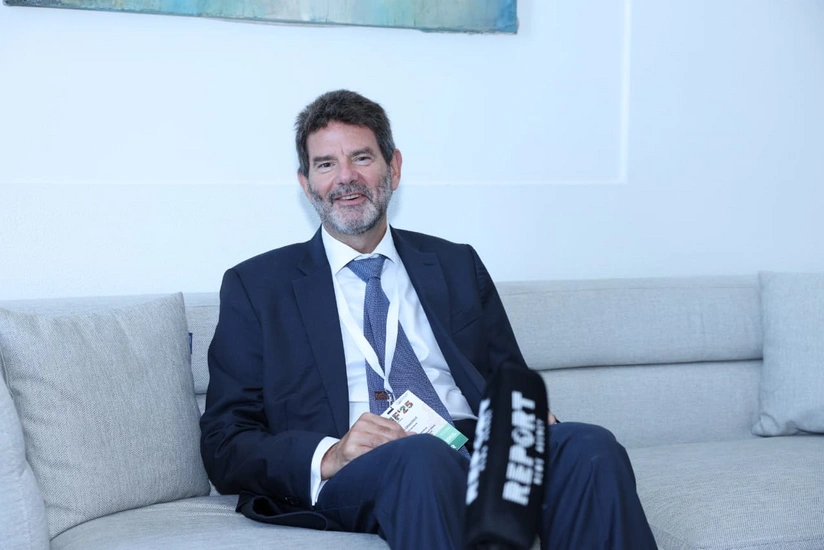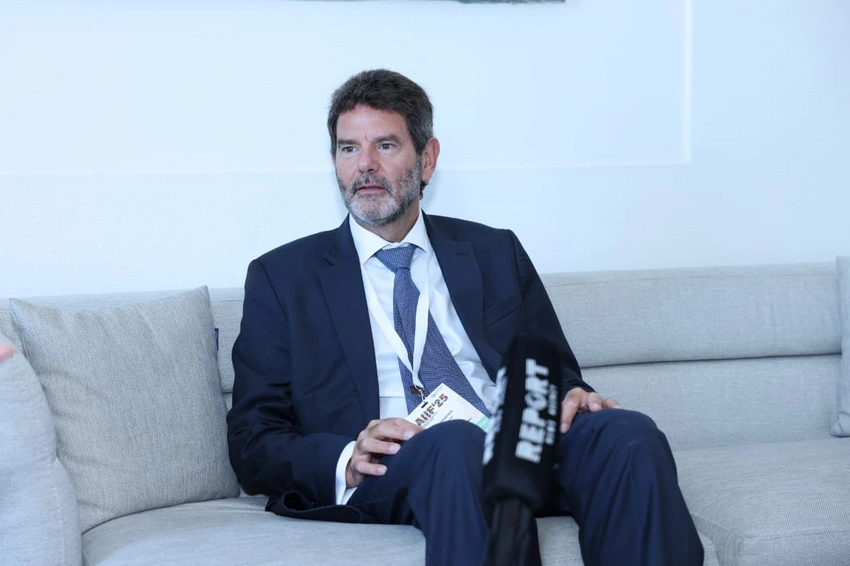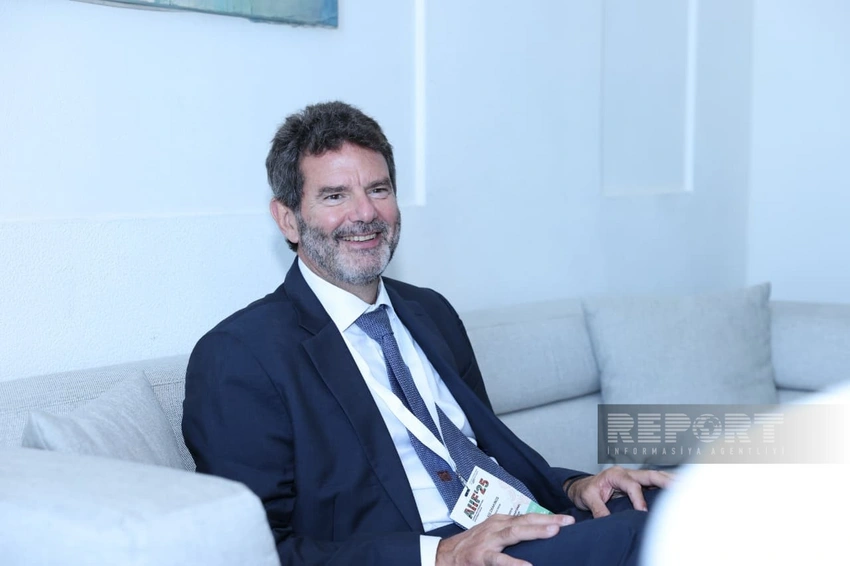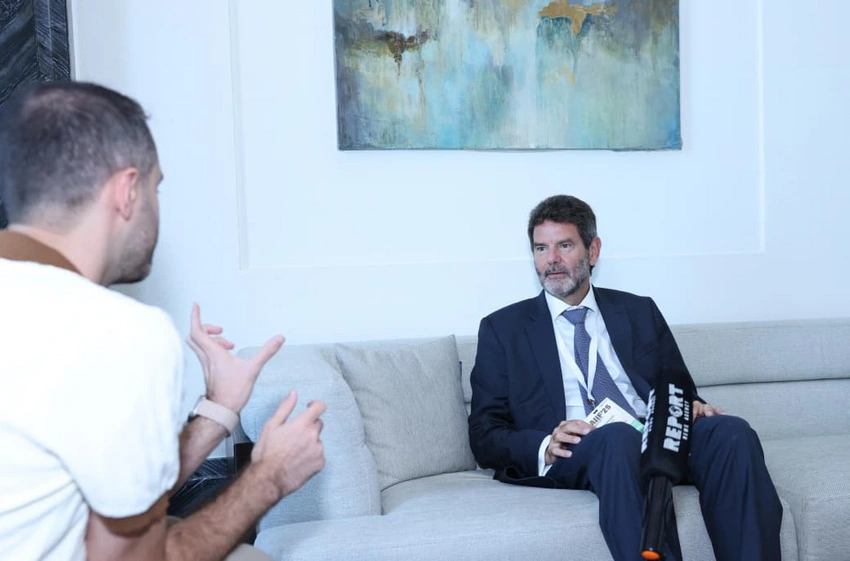Alkis Drakinos: US-backed agreement may reshape connectivity landscape across Caucasus - INTERVIEW
- 15 October, 2025
- 16:00

Azerbaijan is on the threshold of a new stage of economic development: the country is actively diversifying its economy, expanding its participation in the green agenda, and strengthening its role as a transport hub at the crossroads of Europe and Asia. The European Bank for Reconstruction and Development (EBRD) is one of Baku's key international partners in these processes.
In an interview with Report, Alkis Vryenios Drakinos, EBRD regional director for the Caucasus, discussed why the EBRD is focusing on renewable energy and transport connectivity, what prospects the national hydrogen strategy offers, and how green corridors can transform the regional economy.
Report presents the interview:
- Mr. Drakinos, how would you generally characterize the priorities and strategic directions of the EBRD"s activities in Azerbaijan in the coming years? In your view, which areas are the most promising for deepening cooperation?
- Our strategic priorities for Azerbaijan over the coming five-year period are well adjusted to the country"s promising economic outlook and competitive advantages: We shall be focusing on supporting economic diversification, advancing the green transition, and strengthening the country"s role as a hub for regional connectivity. Importantly, these align closely with both Azerbaijan"s ambitions and our mandate.

On diversification, we will keep up our strong support to the private sector, from advising start-ups through our Star Venture Programme, to supporting with financing and needed technical assistance the SMEs, larger corporates, and partner banks, helping expand their competitiveness and promoting access to finance.
On the green agenda, momentum is strong: we"re proud to be the only international financial institution involved in every utility-scale renewables project in Azerbaijan to date. Combined, these projects bring well over 1 gigawatt of clean energy, and we believe it"s only a start!
And on connectivity, we understand well that Azerbaijan"s location makes it central to the Middle Corridor. The progress achieved in the US-backed peace framework shows promising signs to further strengthen regional connectivity, opening new opportunities for trade, investment, and inclusive growth. Ideally, this connectivity will not only be faster and more reliable, but also greener and more sustainable. And the EBRD is very well-placed to help with that.
We"re all very excited about this promising new chapter in our partnership!
- The EBRD pays great attention to sustainable and green initiatives. Is the Bank interested in projects related to green corridors through Azerbaijan, and in what ways could it be involved in their implementation? What factors are key for you when deciding whether to support such projects?
- Sustainability is central to our mandate. How can we be involved? We can finance or co-finance large-scale transport upgrades, blend in donor funds for the sustainable components and run rigorous feasibility work – technical, environmental and social to de-risk projects, make them bankable and maximise their benefits for all stakeholders involved. We also help identify both investments and the ‘soft" measures that make the system seamless, sustainable and competitive.

What green corridor solutions look like in practice: multimodal integration (rail–port–sea–road), logistics digitalisation and energy-transition measures along the route. A concrete example is our contrailer study with Georgian and Azerbaijan Railways to shift trucks, with drivers, onto rail between Batumi and Baku, cutting congestion and emissions.
When considering investing, decision factors will include clear economic viability and bankability, genuine, measurable green impact and strong commitment from all stakeholders. Green corridors are about cleaner, smarter connectivity and an ecosystem of economic actors partnering with each other. The EBRD, with its experience, is the right partner for this.
- The Bank has supported the development of Azerbaijan"s national hydrogen strategy. In your opinion, what should be the next steps for its practical implementation? In which areas could cooperation with the EBRD be most productive - production, export, technology deployment, or regulatory improvement?
- Indeed, we supported the authorities in preparing Azerbaijan"s first National Hydrogen Strategic Outlook, presented at COP29. Now we"re helping authorities with the strategy itself, to move to practice. Needed steps include introducing clear regulation and piloting projects powered by the country"s growing renewables base and the right infrastructure to connect hydrogen with grids, industry and potential export routes.
The EBRD is now bringing value in helping build the regulatory framework. We could also consider investing in pilot projects and helping to integrate with wider energy systems. For us, the key factors are economic viability, measurable decarbonisation and strong stakeholder commitment. With these in place, we can do a lot together!
- The Baku International Sea Port is preparing to implement the second phase of its expansion. Is the EBRD considering participation in this project - both in terms of financing and technical support? What priorities does the Bank see in the development of port infrastructure in the wider region?
- We are closely following the Port of Baku"s expansion plans and stand ready to consider participation if the conditions are right for all. Our priorities in port infrastructure are clear. We want to ensure that projects are financially sound, environmentally sustainable and supportive of regional connectivity.
It is also important to consider ‘bigger picture" concepts in terms of end-to-end connectivity and ongoing or expected capital investments in other parts of the routes. We are already closely involved in development of transport infrastructure on the other side of the Caspian Sea, including in Aktau Port. So, we see a strong potential for future cooperation and are ready to engage.
- Recently, the Zangazur Corridor (also referred to as the "Trump Route") has been widely discussed. How does the EBRD assess the prospects of such cross-border initiatives? Could the Bank play a role in supporting them, given the political and regional sensitivities involved?
- We welcome steps that strengthen regional connectivity and contribute to lasting peace. Cross-border initiatives such as the US-backed framework could give the Middle Corridor greater scale and resilience as a route between Asia and Europe. This agreement could reshape the connectivity landscape across the Caucasus.
Our Office of the Chief Economist, in its most recent Regional Economic Prospects, confirmed that this progress could unlock new trade routes, improve investor confidence, and boost the economic growth of the whole region.
The EBRD can support with long-term financing for major infrastructure works, including in Nakhchivan, for example, and mobilise donor funds, including for sustainable elements. We also bring to the table our extensive experience in technical support and policy dialogue.

- At COP29, the EBRD supported the introduction of competitive auctions for renewable energy sources in Azerbaijan. Are new auctions expected to be held in the near future with the Bank"s participation, and what outcomes do you anticipate from this mechanism?
- We are proud to have supported the authorities in preparing Azerbaijan"s first competitive renewable energy auction, which was completed almost a year ago at COP29 with the selection of the winning bidder. This was an important milestone: auctions bring transparency, competition, and lower costs, which are exactly the conditions investors need.
The first auction round and the associated revisions in the legal and regulatory system have laid the ground for further rounds. Now, we stand ready to provide both technical support and financing. Our expectation is that this mechanism will attract more international players and their high-quality private investment, accelerate the build-out of wind and solar capacity, and deliver clean power at competitive prices. We have plenty of reasons to be optimistic in that regard.

